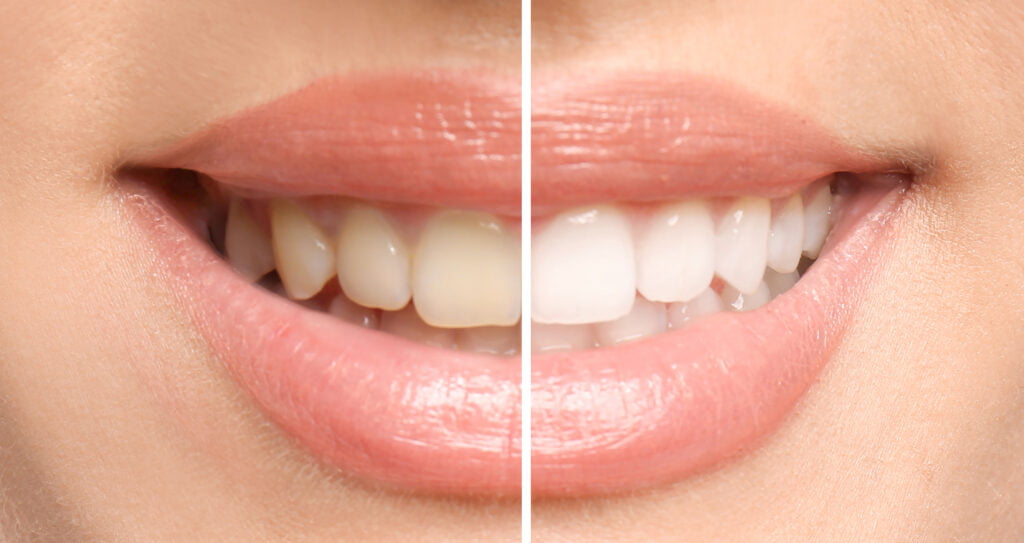Teeth Whitening Treatment: Types, Pros, and Cons
Stains on teeth can build up, even if you brush for the recommended 120 seconds twice daily and regularly use mouthwash and floss. Certain drinks like red wine, untreated dental cavities, and even eating dark fruits can alter your teeth’s shade.
Teeth whitening is one of the most popular cosmetic dental treatments for dental discoloration. And it’s a great way to improve your smile and boost your confidence.
But with so many different types of treatments available, it can be challenging to choose the best option. In this blog post, we’ll explore the different types of teeth whitening treatments and help you decide the teeth whitening treatment that’s right for you.
But first, understand the basics to help you make an informed decision.
Types of Teeth Stains
To effectively whiten your teeth, you must choose a treatment option that removes the type of stains you have. Two types of teeth stains are:
1. Intrinsic stains: They are exactly what the name suggests. The stains occur inside your tooth’s enamel rather than on the surface.
Overexposure to fluoride and using certain medications (like tetracyclines) can cause intrinsic stains. Your tooth enamel growing thinner as you age can also cause intrinsic stains. According to 2014 research, intrinsic stains can sometimes be genetic.
2. Extrinsic stains: They appear on the tooth’s surface. Smoking, coffee, and artificial food colorings are the typical cause of extrinsic stains. According to the 2014 research (above), antibiotics can sometimes cause this type of staining.
Generally, over-the-counter teeth whitening methods are the least effective in removing stains. Especially intrinsic ones. On the other hand, both extrinsic and intrinsic stains are best removed professionally because an expert tailors the treatment to your needs.
But we don’t want to be biased on what teeth whitening method you should choose. We compare several treatment options below to help you make an informed decision based on their pros and cons.
Teeth Whitening Options
Some teeth whitening products work by removing extrinsic stains. Others simply bleach the stains (intrinsic and extrinsic) to achieve the desired shade. Here’s a complete breakdown of different teeth whitening options.
1. Over-the-Counter (OTC) Teeth Whitening
OTC teeth whitening products reduce dentist visits because they are readily available online and in drugstores.
They contain bleaching agents such as hydrogen peroxide or carbamide peroxide that remove stains and discoloration from the teeth. Common OTC teeth whitening products include:
- Abrasive toothpaste
- Gels
- Strips
- Generic trays
While OTC whitening products are cheap, they are only suitable for mild teeth staining. Excessive staining may require professional treatment. Generally, OTC teeth whitening products can be effective, but they are less powerful than professional treatments.
They also come with side effects such as gum irritation and tooth sensitivity. It is essential to follow usage directions closely. Talk to a dentist if any concerns arise.
Pros
- Cheaper than professional teeth whitening treatments
- Readily available online or in drugstores
- Available in different forms
- Relatively safe if you follow instructions
Cons
- Less effective compared to professional teeth whitening treatments
- Lack of professional guidance makes it difficult to know if the product is working or damaging your teeth
- Takes longer than professional treatment to see results
- Must be used repeatedly to be effective
- Dental strips and generic trays may not fit firmly on your teeth
2. LED Teeth Whitening Kits
LED whitening kits are a great option if you’re on a budget and want a more effective treatment than what OTC products offer. The kits come with a mouth tray and a bleaching gel. They also have an LED light that activates the gel and is believed to accelerate the whitening process. The light breaks down the gel and enables the bleaching agent to penetrate the enamel, enhancing stain removal.
The kits usually come with a manual that shows how to use them in the comfort of your home and get the best possible results. The results are typically noticeable after just one use.
Like most OTC whitening products, however, LED whitening kits have side effects such as tooth sensitivity and gum irritation. The risk of side effects increases with the type and concentration of the whitening agent as well as treatment duration.
Pros
- Inexpensive
- At-home use reduces trips to the dentist
- Requires shorter treatment time than OTC products to see results
- Generally safe
Cons
- Treatment takes longer than in-office treatment to work
- More expensive than OTC teeth whitening products
3. Professional (In-Office) Teeth Whitening
Professional teeth whitening is your best option if you’re looking for the safest, most effective, and quickest way to remove dental stains. Reliable dentists use their knowledge and experience to tailor the treatment to your needs and ensure it’s as effective as possible.
Professional teeth whitening is expensive, but you get incredible results quicker than all other treatment options. You can whiten your teeth to achieve several shades. That’s because your dentist can use higher concentrations of bleaching agents and leverage modern technology.
For example, Dr. Wanda Hall—a dentist with over two decades of experience—uses the Opalescence Whitening System. This technology allows him to use a highly concentrated and chemically activated whitening gel to remove stains within an hour. You get immediate results and can achieve stain removal for up to eight shades in a single application.
Pros
- Higher concentration of the bleaching agent to achieve different shades
- Whitens teeth more than any other treatment
- Immediate results
- Dentists protect your gums using shields
- Doesn’t require repeated treatments to achieve the desired results (treatment can be semi-annually or yearly)
- Professional guidance to minimize the risk of side effects
Cons
- Expensive
- Can cause temporary sensitivity
4. Professional, Custom-fit Teeth Whitening Trays
A dentist can prescribe a custom-fit teeth whitening tray. You place the tailored tray to fit into your teeth and wear it for some time during the day or overnight. The trays contain whitening agents such as hydrogen peroxide or carbamide peroxide.
If you follow your dentist’s instructions, custom-fit whitening trays bring results quickly. Advanced technology is the reason behind custom-made whitening trays. For instance, A Healthy Smile dental clinic uses Stratasys 3D printer to make an exact model of your teeth.
The result? You get a custom-fit tray within 24 hours with professional-grade whitening gel. One of the biggest perks of custom-made trays is they fit neatly. And you can use them at home without visiting the dentist frequently.
Pros
- Usable in the comfort of your home
- 100% guaranteed to fit your dental structure
- Professional grade gel accelerates results
- Advice and instructions from an expert
- More affordable than a complete in-office whitening treatment
Cons
- Takes longer than complete in-office treatment to work
- May cause temporary teeth sensitivity
Not sure what’s right for you? Ask your local dentist about the best teeth whitening treatment that suits you. Our clinic is located in Bon Air, Virginia. Contact us today for a whitening treatment that will improve your smile.

